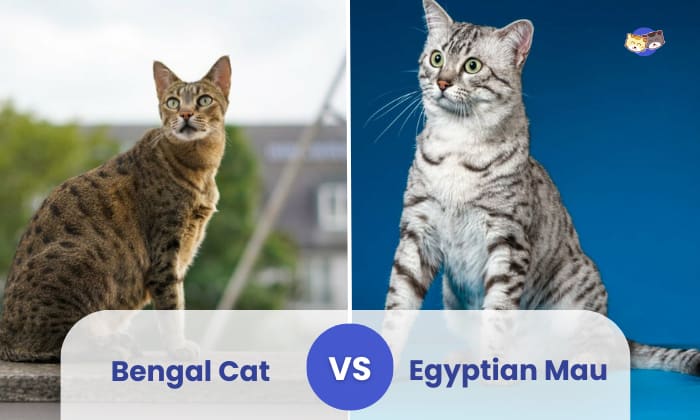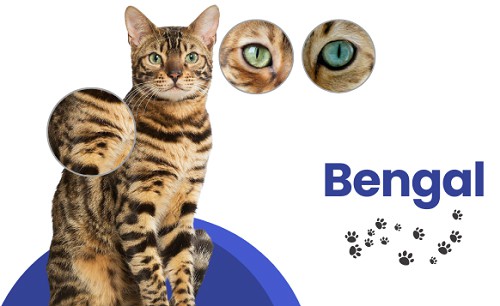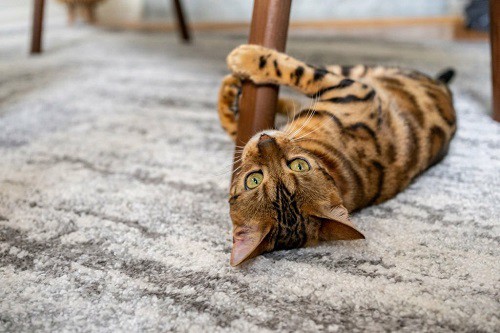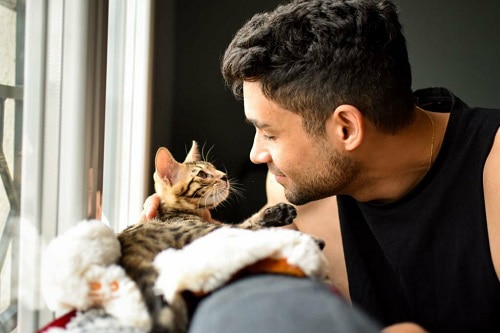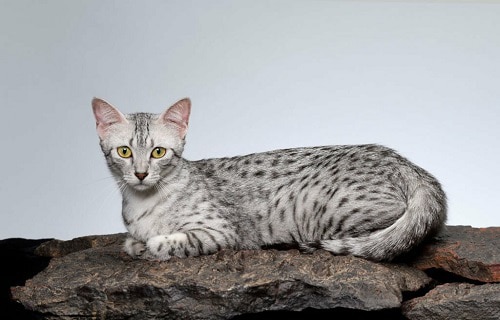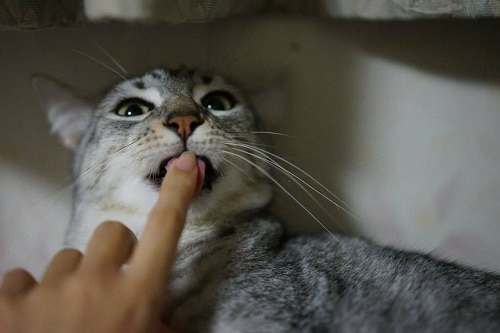Choosing between Bengal and Egyptian Mau breeds is like selecting from a palette of elegance and adventure in the world of domestic cats.
Picture this: the Bengal, a mini leopard bounding through your living room, and then there’s the Egyptian Mau, a living relic from ancient Egypt with its graceful presence and distinctive green eyes.
In this feline face-off, we’ll explore the distinct features that set Bengal cat vs. Egyptian Mau apart.
| Aspect | Bengal Cat | Egyptian Mau |
| Physical Traits & Appearance |
|
|
| Temperament & Behavior |
|
|
| Care Requirements & Health |
|
|
| Average Height (Adult) | 10-16 inches (25-41 cm) at the shoulder | 10-14 inches (25-36 cm) at the shoulder |
| Average Weight (Adult) | 8-15 pounds (3.6-6.8 kg) | 6-14 pounds (2.7-6.4 kg) |
| Lifespan | 12-16 years | 12-15 years |
| Exercise | High energy, requires regular play and exercise | High energy, needs ample playtime and stimulation |
| Grooming Needs | Low to moderate | Low |
| Family-Friendly | Yes, can be good with children and other pets | Yes, generally good with children and other pets |
| Other Pet-Friendly | Can get along with other cats if properly introduced | Can get along with other cats if properly introduced |
| Trainability | Intelligent and can be trained with patience and positive reinforcement | Intelligent and can be trained with patience and positive reinforcement |
| Cat Price | $1,500 to $3,000 USD | $900 to $2500 USD |
Table of Contents
Which Breed is Right for You: Bengal vs Egyptian Mau
1. Bengal
History and Origin
If you’ve ever dreamed of having a domesticated version of a leopard in mini size, the Bengal cat might be the perfect match for your preferences.
This unique breed emerged from the deliberate crossbreeding of several feline varieties, including the Abyssinian, American Shorthair, Egyptian Mau, and Asian leopard cat, with its development commencing in the 1960s.
Crossbreeding these breeds aims to achieve an offspring that would closely resemble the wild ancestor’s (leopard) beautiful markings.
Even though the Bengal cat is said to have originated from California, most of its hybrid qualities come from Southeast Asia. The official name of the breed, “Bengal cat,” was officially coined by Bill Engler in 1974. The term came from the scientific name of the Asian Leopard Cat Prionailurus bengalensis.
Physical Traits and Appearance
Bengal cats are known for their striking facial markings. As mentioned, it is closely similar to a leopard’s appearance. What is magical about this breed is their coat glitters when hit by light rays. It can come in different colors, like brown, orange, sand, rust, and ivory.
Meanwhile, their leopard-like spots can be rust, black, or brown. Commonly, you will see their large eyes in yellow or green.
Temperament and Behavior
The Bengal cat is known for its dynamic and engaging temperament. You will immediately notice its spirited and highly active attitude. Most of the owners are captivated by their displaying a zest for life. This breed is also known for its intelligence.
Bengals are quick learners and thrive on mental stimulation. They are naturally curious and often enjoy interactive play, making them a lively addition to any household. Despite their energy, Bengals are also affectionate and can form strong bonds with their human companions. They tend to be vocal and expressive, eager to communicate their desires.
Between Egyptian mau vs Bengal, the latter may be more reserved around strangers, showcasing their independent streak. Bengal cats can be loving and devoted family members with proper socialization and care.
Care Requirements and Health
As mentioned, Bengals are active; thus, you need to set up some climbing trees or obstacles as an owner. Also, give your Bengal cat interactive toys and teach it to play fetch or catch a laser dot.
Since these breeds are huge shedders, you must groom them weekly. Clean their litter box daily and trim their nails every 3 to 4 weeks.
Bengal cats are prone to conditions like Autosomal recessive disorder (early blindness), Entropion (eyelid rolling in), and Feline infectious peritonitis caused by coronavirus infection. This is why your cat needs all the important immunizations and health treatments to prevent this from happening. Regularly bring them to the vet for check-ups.
2. Egyptian Mau
History and Origin
The Egyptian Mau is an ancient and revered breed believed to trace its lineage back to ancient Egypt. Known for its graceful, slender appearance and distinctive green eyes, this breed was revered in Egyptian society for its elegance and hunting prowess.
Pharaohs highly value this breed. A Russian Princess named Nathalie Troubetzkoy brought the first Egyptian Mau to the US in 1956.
You might also encounter the popular Egyptian Mau mix with the distinctive shorthair domestic cat breed.
Physical Traits and Appearance
The Egyptian Mau is a striking breed characterized by its sleek and muscular body. It boasts a shimmering coat that lies close to the skin, giving it a refined appearance.
Its elegant, short coat and lithe physique make it an excellent hunter, meaning they are good mousers, traits preserved over thousands of years.
One of its most captivating features is its large, almond-shaped, vivid green eyes framed by distinctive, dark mascara-like markings.
Its coat is typically silver-gray with a beautiful sheen, and its legs are long and slender, allowing for agile movement.
Care Requirements and Health
Taking care of an Egyptian Mau involves relatively straightforward maintenance.
Due to its short coat, grooming needs are minimal, requiring only occasional brushing to keep its coat healthy and free of loose hair.
These cats are generally robust and healthy, but it’s essential to provide regular veterinary check-ups to monitor for any breed-specific health concerns, such as potential issues with hip dysplasia and renal disorders.
Regular interactive play sessions help fulfill their need for exercise and mental stimulation, ensuring a happy and contented feline companion.
Conclusion
Bengal cat vs. Egyptian Mau, what should you choose? These two breeds offer unique and captivating characteristics to potential cat owners. The Bengal brings a touch of the wild into domestic life, making it an energetic and engaging companion.
On the other hand, the Egyptian Mau’s ancient elegance and graceful presence offer a blend of history and contemporary charm, making it an excellent choice for those seeking a refined yet active pharaoh cat.
We hope this comparison guide has helped you choose the right breed.

I am Amy Sawy, a Doctor of Veterinary Medicine (DVM) graduate from the University of Kansas. y husband, Dr. Plummer, and I own a veterinary clinic in Phillipsburg, Kansas. In addition to my professional background, I am a devoted pet owner myself, with a household that includes dogs, rodents, and most notably, cats – a total of five felines in my home.
In 2020, I joined an organization as a professional writer, leveraging my experience and collaborating with my team to deliver the most valuable information for your cat’s care.


